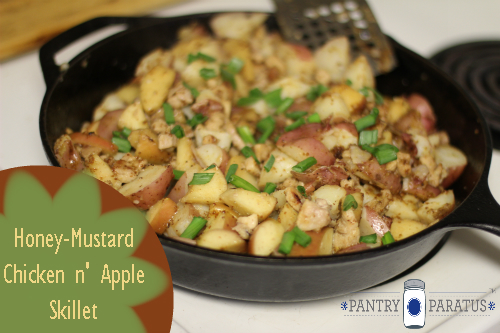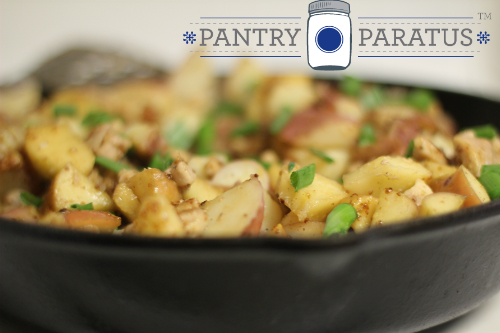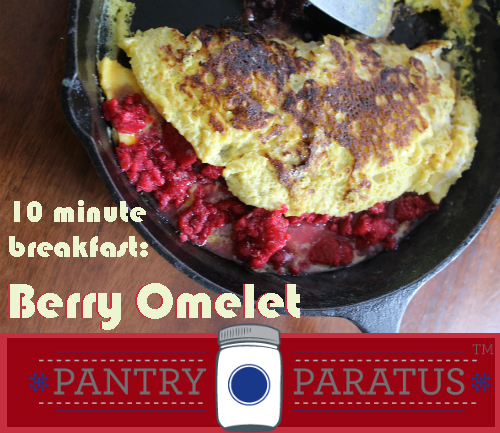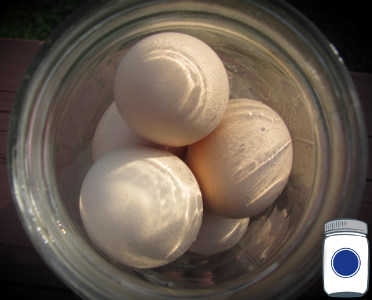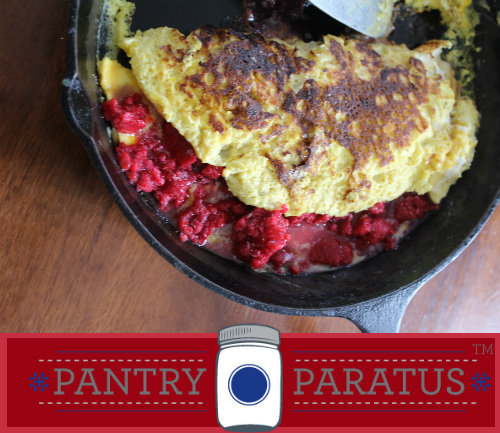“The New Primal” Review
Grass-fed beef jerky that can keep pace with your life
The New Primal sent four packages of their grass-fed beef jerky to me, and here is my review. They did not compensate me in any way, nor did they have a clue what I’m about to say here.
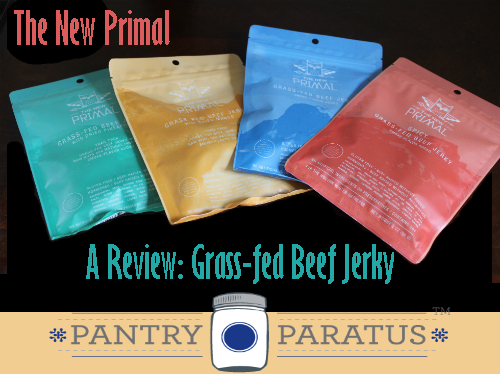
They sent four flavors to me: Original, Spicy, Mango, and Pineapple.
Once while in line at the grocery store, my over-honest toddler told the clerk, “My mommy says that stuff (pointing to the “meat sticks”) is yucky.” I was slightly embarrassed but I couldn’t exactly reprimand him, could I? Finding a quick high-protein snack is difficult for those of us who care about GMO, ethical harvest, natural animal practices, and….flavor! I gave up on any jerky that was not my own a loooong time ago. And even then, mine isn’t all that great.
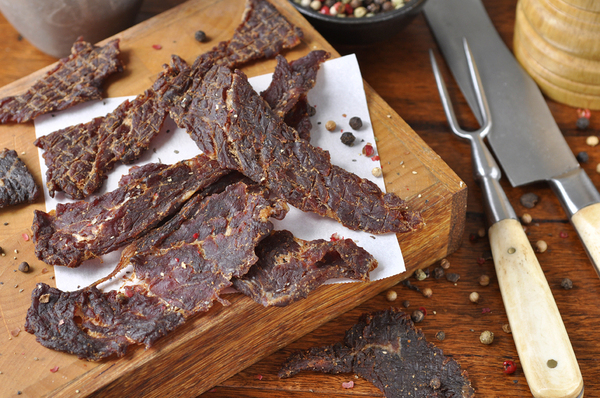
The Ingredients: This is why I even agreed to do a review in the first place. They only use grass-fed beef. They marinate and smoke the meat using nourishing ingredients and natural processes. Oh, and it is gluten-free. The trail packs are like nothing else in flavor, that I promise. They pair the marinated beef with raw nuts and fruits. Each trail pack has 18 grams of protein per bag! You can hike that trail or survive that traffic jam.
For us, it was getting through all-day air travel (we refuse, flat-out refuse to eat anything from an airport and always bring our own food), surviving an amusement park, and spending a day on the lake in a canoe. Those were the adventures we chose, but this is one of those great “choose your own ending” adventure stories. What’s yours?
I asked the company a few questions. I asked, “With all of the health food brands on the market, I see nothing out there that claims to be grass-fed jerky. Can you tell me exactly where New Primal picks up where others leave off? What makes it different?”
They responded:
We’re committed to only using 100% Grass-Fed, Grass-Finished beef that are raised without hormones and antibiotics because that’s the way nature intended it. We also don’t see the need to add loads of salt, sugar, or any ingredient you can’t pronounce which is the typical model in this category. The New Primal doesn’t use sugar in our marinade and have 50% of the sodium content of the average bag of jerky on the market. There’s no reason jerky should be a gas-station snack. It can be clean, great tasting, and a quality source of protein.
‘Nuff said.
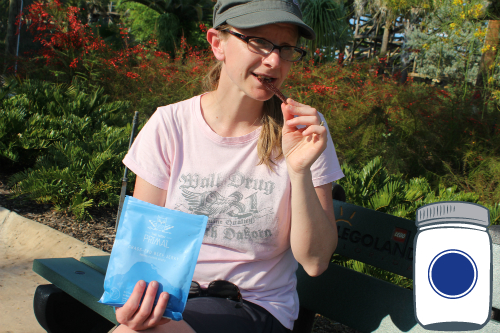
The Packaging: Very sleek, easily conforms to our day-hike bag, to the carry-on, and I slipped one in my purse for a mid-day snack on the go. Each flavor is easily identified by its own packaging.
I’m obsessive-compulsive about label reading; since a kid has a corn allergy & corn has over 180 names, I read every package at least 3 times before letting him eat stuff. I know-that-I-know-that-I-know none of their jerky contained the allergen, and yet I was slightly annoyed at trying to read the yellow package (the mango) for the third time because the white print was barely legible. I recommend checking out the ingredients list directly on their website and let the OCD go. Really. Relax. You read the label already. These people are OUR people, the traditional food people, relax. I did tell the company that this was my singular complaint, and they said that it was simply a bad batch of packaging from the printer and that the problem was remedied. That SO happens to everyone.
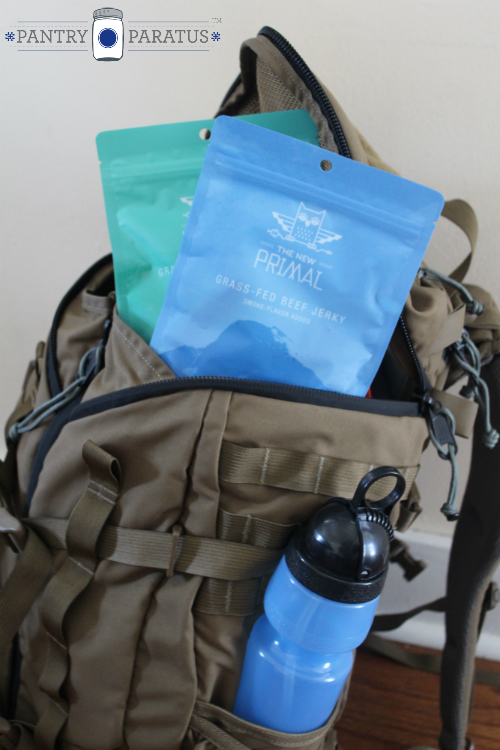
We also take our Berkey system water bottle everywhere–just in case.
The Texture: I dragged that jerky around with me everywhere, quite literally. I left it in the car, which was fluctuating to extreme temperatures in our Montana spring. I carried it around in a backpack at a Florida amusement park in 95 degree heat. It was downright abusive.
The texture is far tenderer than my homemade jerky. My kids even made the comment, which resulted in an eye roll from me, I confess. My son thought the original flavor was too greasy, but I think it had to do with the abuse we gave that package—nothing else was “too greasy” at all, and all of it was delicious.
The Flavor: The sweetness of the meat itself is a common denominator, and the meat flavor is consistent from bag to bag. The pairing with pineapple, mango, or nuts will be preferential but we liked them all!
I saved the spicy for last because I am a wimp. It has a sweet-spicy flavor (probably due to the honey and pineapple juice in the mix), so it was more like “strong-tangy” than spicy. I mean, I ate the entire bag by myself and my lips had that tingly feeling. It wasn’t caliente.
The mango was my favorite.
The Price: It’s hard to gauge the price of anything unless you do some comparison shopping. I pulled up the most common brand name online (Jack Link’s) and saw, penny-for-penny the same price. I then read the ingredients list. It has MSG, GMO soy, added nitrites, and GMO corn going by 3 aliases. It had some other stuff like preservatives I’ve yet to research. That stuff is never invited into my home. Or my backpack. Same price.
I was more surprised than you know about the “same price” thing. So I asked, “The nasty stuff on the market (like the “meat sticks” in the checkout line) is all way over-priced, in my personal estimation as a consumer. You give real nourishment at a very similar price-point to theirs. Still, jerky seems to be somewhat of an impulse buy for many people, something they get at a quick gas stop or when their picking up sunscreen for a day at the beach. Why should beef jerky be a conscientious, plan-ahead purchasing decision?”
They answered:
It’s without question that a protein rich diet benefits personal health in many ways. Jerky makes for the ideal “portable protein”. It’s the perfect snack in-between breakfast and lunch or lunch and dinner and can save your life in traffic or while traveling. It doesn’t have to be exclusive to the hiking trip and should be something that we keep a few packs of in our pantry, briefcase, or purse for those moments we’re tempted to hit the vending machine at work, etc.
Healthy, nourishing protein can be hard to come by in a hurry. Put a pack of this stuff in your bag on your way out the door and you won’t be tempted to “stop for a quick bite” that is only going to sicken you later. You’ll also save money by doubling the nutritional value of each penny you spend. You have a busy life and you need real nutrition to keep you going; this stuff can keep up with you!
You can get The New Primal Grass-Fed Beef Jerky directly on their website or you can check out their listing of who sells New Primal near you by visiting http://thenewprimal.com/
Photos are either property of Pantry Paratus (if the jar logo is present) or are property of The New Primal and used with permission.
